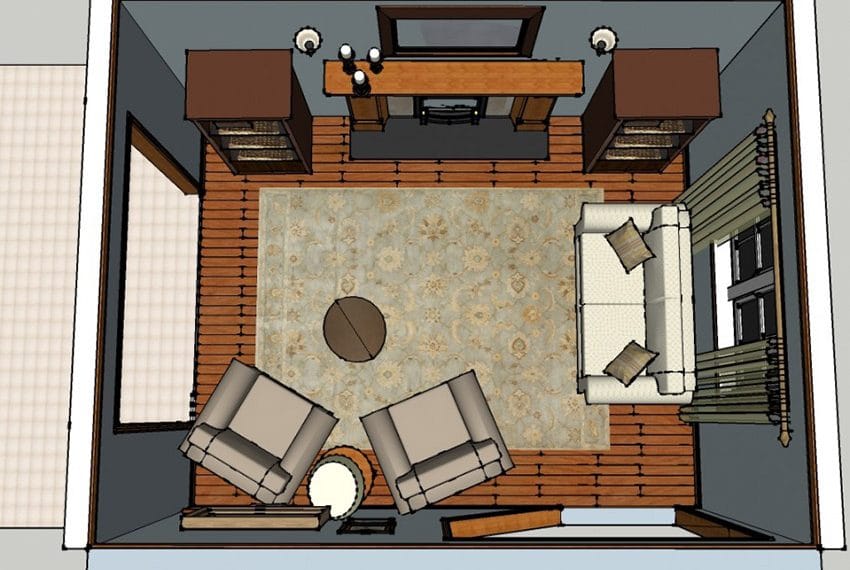Planning Your Space
How well do you know your room? In order to shape and dress it, you need to know and understand your room as well as you know yourself. Go to the room you need to organize or rearrange and ask yourself these questions: What are the dimensions of your room, and what is its basic shape? Is it square, rectangular, L-shaped? What are your room’s problems? Does it have a ceiling that’s too low? Is it overly long and narrow? Does it lack any distinguishing points? Does it have a focal point that’s off-center?
Q: What are your roomets? Does it have beautiful moldings or a picture window?
Create a rough floor plan by drawing around anything that is permanently attached to each wall. Using a l/4″ to 1′ scale, finalize the plan with a ruler, denoting doors, windows and anything permanently attached to the wall.
Using Floor Plans
The best way to understand your room’s shape–with all its intractable ins and outs–is to draw a floor plan. Draw one now, allotting 1/4″ to each linear foot that forms the baseline of your walls.
Draw behind any movable piece of furniture–because if you can move it, you may want to when you rearrange your room. Mark the width of the gap forming any doorway, whether it’s a major doorway or a doorway to a closet. And even though your windows aren’t at the base of your floors, mark where they start and end. That way, when you go to use your floor plan to try out different furniture arrangements.
Now, using lengths and widths only, make yourself simple cut-outs of your anticipated furniture pieces in the same 1/4″ = 1’0″ scale.
Your floor plan can help you visualize where to place furniture, how many furniture pieces will fit into your room and where the traffic paths need to be. But it won’t reveal other key details, such as your room’s personality and the height of its walls.
The clues to your room’s true nature lie in its architecture. Do you see thick, ornate Victorian moldings around the top of your walls and windows? Then your furniture should have equally weighty materials and carvings. Does your room have a curved wall or mantel, or a prominent bow window? Then a round or semi-circular piece of furniture, or a round or semi-circular furniture arrangement could complement it. If your room is a blank slate architecturally, you may want to add visual dimension via paneling, stenciling, a chair rail, a series of French doors or a Dutch door.
If your room has low ceilings, keep your furniture lines low.
Overcoming a room’s weaknesses
If your room has low ceilings, keep your furniture lines low. Choose sofas and chairs with low backs, unless you’re an unusually tall person. For personal comfort, seatback height should be closer to your shoulders than to your waist. Keep cabinetry heights below eye level, or let your cabinetry stretch all the way to the ceiling &ndash you don’t want to inadvertently produce an even lower visual height cap for your walls. Avoid using cornices over the windows of a low-ceilinged room for the same reason.
You can raise your walls’ visual height by hanging pictures, plates or a shelf full of objects over your windows and doors. You can make your walls seem taller by painting them and any cornice molding into the ceiling. Use the same color as the ceiling to minimize the wall/ceiling delineation. Use light, satiny, cool colors, since they make space recede.
Warm, dark, matte colors advance space. Use them if you want to make your room feel smaller and cozier (avoid them if you don’t). In a room that’s overly long and narrow, you can use warm colors on the shorter walls to pull them forward and make the room feel squarer.
If your room has an awkward shape, or a lot of built-in obstructions, or an off-center focal point, use your furniture arrangements to visually divide your room into a series of more manageable “mini-rooms” within the room. Create a clustered seating arrangement in one area of the room, say, around a fireplace (remember, you don’t have to place all your furniture against the walls). Create a separate arrangement &ndash a grouping of plants, a chaise, a desk or a piano &ndash in another area of the room to balance it. Use area rugs to enhance definition.
If your room has a particularly attractive feature like a picture window, let it be what the eye goes to first by making it the most colorful or elegant feature in the room and/or centering your furniture arrangement around it.

